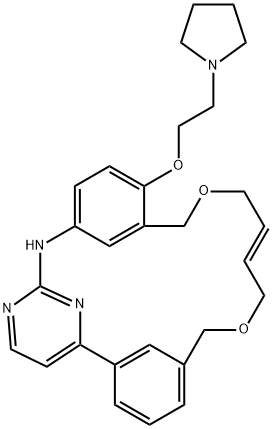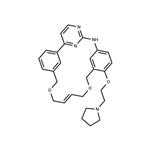Description
Pacritinib received accelerated approval in 2022 for the treatment of adults with intermediate or high-risk primary or secondary (post-polycythemia vera or post-essential thrombocythemia) myelofibrosis with a platelet count below 50 × 109 /L, which affects 26% of all myelofibrosis patients (~20,000 in the United States). Unlike several other JAK2 inhibitors, pacritinib exhibits good selectivity (~60-fold) for JAK2 over JAK1 while also inhibiting JAK3 with about 25-fold lower potency than JAK2. Pacritinib exhibits equipotent activity against FLT3 (IC50 = 22 nM) and mutant FLT3-D835Y (IC50 = 6?nM) at the same potency range as JAK2 (JAK2 IC50 = 23 nM).
Characteristics
Class: non-receptor tyrosine kinase (JAK3)
Treatment: myelofibrosis
Elimination half-life = 40 h
Protein binding = 99%
Uses
Pacritinib is a JAK2/FLT3 inhibitor used in the treatment of acute myeloid leukemia showing significant tumor growth inhibition and lung metastasis.
Mechanism of action
Pacritinib competes with JAK2 for ATP binding, which may result in inhibition of JAK2 activation, inhibition of the JAK-STAT signaling pathway, and so caspase-dependent apoptosis.
Enzyme inhibitor
This pyrimidine-based macrocycle and potent protein kinase inhibitor (FW = 472.59 g/mol; CAS 937272-79-2; Solubility: 11 mg/mL DMSO), also known as SB1518, selectively targets Janus Kinase 2 (or JAK2; IC50 = 23 nM) and Fms-Like Tyrosine Kinase-3 (or FLT3; IC50 = 22 nM), with values of 1280 and 522 nM for JAK1 and JAK3. FLT3 is genetically altered in up to 35% of acute myeloblastic leukemias, making it an attractive target for AML patients. Pacritinib has potent anti-proliferative effects on myeloid and lymphoid cell lines driven by mutant or wild-type JAK2 or FLT3, resulting from cell cycle arrest and induction of apoptosis. SB1518 has favorable pharmacokinetic properties after oral dosing in mice, is well tolerated and significantly reduces splenomegaly and hepatomegaly in a JAK2(Val-617-Phe)-driven disease model. Primary Mode of Inhibitory Action: Upregulation of JAK2 in FLT3-TKI-resistant AML cells was identified as a potential mechanism of resistance to selective FLT3 inhibition. This resistance could be overcome by pacritinib’s combined inhibition of FLT3 and JAK2 in this cellular model. Pacritinib potently inhibits FLT3 auto-phosphorylation and downstream STAT5, MAPK and PI3K signaling pathways in AML cell lines with highest potency against cells harboring FLT3-ITD mutations. Blockade of FLT3 signaling was also demonstrated in primary AML blasts treated ex vivo with pacritinib. In both cell lines and primary blasts, pacritinib treatment led to the induction of G1 arrest, inhibition of cell proliferation, as well as caspase-dependent apoptosis. The anti-proliferative effects of pacritinib on the FLT3-ITD harboring cell lines MV4-11 (IC50 = 47 nM) and MOLM-13 (IC50 = 67 nM), which have been reported previously,16 are in the same range as the inhibition of intracellular FLT3 signalling.



